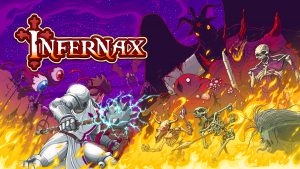
From developer Panstasz comes a captivating love-letter to cosmic horror, and to the stories and storytellers that wove its rich tapestry. When I first sat down with World of Horror, I wasn’t quite sure what to expect. From my pre-game research, I was able to gather the general gameplay and aesthetic goals of the developer. A classically styled roguelite RPG set in a world clearly inspired by horror writers like Junji Ito and H.P. Lovecraft. With this knowledge, I could anticipate the difficulty, the combat elements, and the general design of enemies and locations. What I couldn’t anticipate before sitting down with the game, released in early access on February 20th, 2020, was the passion and dedication that Panstasz put into creating an engrossing universe, with rewarding combat and exploration, compelling gameplay mechanics, and a massive amount of replay value, especially remarkable for a game still in early access.

First things first, the artwork is uniquely striking. As I stated before, it’s an art style very much in the vein of classic 80’s text-based, point-and-click adventure games. Oh, and did I mention it’s done entirely in MS Paint? The 1-2 bit (depending on player choice) pixel art commands your attention as soon as the main menu loads. The next thing that hits you is the music. Haunting chiptunes grab you like the reaching tentacle of an eldritch god, and before you know it, your play area is transformed into your protagonist’s apartment. Speaking of protagonists, let’s dive into the writing and storytelling at play. Aided by author Cassandra Khaw (Hammers on Bone), who is in absolutely tremendous form on this project, World of Horror spins a chilling and dastardly web of interconnected mysteries and events, all leading to a climactic showdown with an evil, ancient deity. Seriously, I cannot praise the writing of this game enough. It’ll send chills down your spine and have you looking over your shoulder.
Like I said before, World of Horror is still in early access, and whilst it’s current state is impressive, always be aware that there will be issues when that is the case. There were some mentions of bugs, although I didn’t run across any during any of my playthroughs, a sign that the developer has been vigilant in that regard, but it’s still something to be aware of while the game is in early access. The difficulty of the game is something that might also catch you off-guard at first. Holding true to it’s inspirations in the gaming field, the game can feel fiendishly hard at times. Although it does offer tutorials to help guide you through early combat encounters, it might be better advised to run from most encounters until you can get a better handle on the more complex aspects of the combat system. Expect a lot of trial and error. The game employs a turn-based style of combat, using a system similar to action points to determine how many offensive, defensive, support, or spiritual actions you can take on a turn. You can find several items to assist you in your investigations, or alternatively you can obtain them from enemies, or buy them from the many shops. Be aware that, due to how the game progresses during a playthrough, some of the shops and other helpful services and locations in the game might be less permanent than you might hope. One of the critical mechanics the game uses is a system called Doom. As you visit locations, make decisions, fight enemies, or do pretty much anything besides solving the current mystery, the Doom percentage goes up, and when it reaches 100, that’s game over. It’s a really cool system that helps drive the overarching narrative, but it’s one that I personally found a bit frustrating at times. I had several attempts end at the eleventh hour due to my Doom having built up so much over the course of the investigations preceding the endgame. Again, expect a decent amount of trial and error.

That being said, the trial and error aspect is really a nonissue. Like I said before, the game has a ton of replay value, with a bevy of unique mysteries, enemies, and events that change from playthrough to playthrough. There are several options for customization as well, so you can have a hand in creating your own stories, with several options for characters, and a bunch of cool magic and sanity based skills and events. I’m at around 8-10 hours at this point, and I’ve still got plenty of entries to fill out in the game’s bestiary, events codex, and pantheon of terrifying big bosses.
Overall, I am really enjoying World of Horror. The game is ambitious, and it’s ambition pays off. At a price point of 14.99 USD, I really can’t recommend this game enough – especially when considering the many varying options the game gives players. For fans of cosmic horror, this is a must play. For fans of text-based RPGs and adventure games, this is a must play. Be aware that the game does feature violence, gore, and body horror that typically goes along with this particular niche, so be conscious of that if you’re of a squeamish persuasion. Whilst the difficulty may be frustrating at times, stick with it. It’s more than worth it.
Score: 7.8/10
Published by Ysbryd Games, and developed by Panstasz, World of Horror is available for PC and Mac in early access with a full release planned for 4th quarter 2020, which will see the game also land on the Nintendo Switch and the PlayStation 4.







